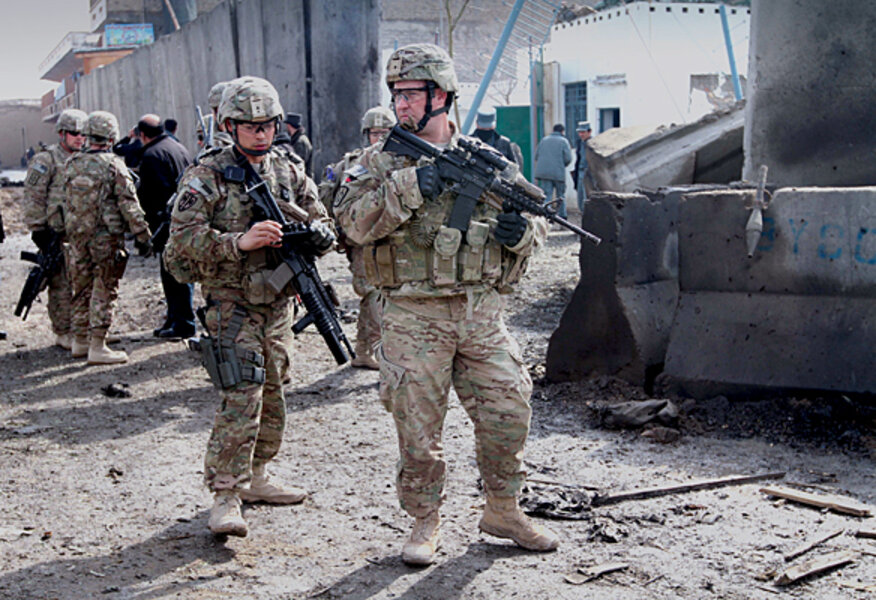The PR challenge in Afghanistan: suicide bombing, Quran burning, and murky data
Loading...
| Kabul, Afghanistan
No matter what the week in the 10-year Afghanistan war, the story out of NATO is always the same: relentlessly optimistic.
Case in point is the last week in February, arguably one of the worst blows to the US image in Afghanistan, when the burning of Qurans on a US military base sparked protests that killed 40. Four Americans were among the dead, two of them shot in their offices at the Interior Ministry in Kabul.
Pentagon press secretary George Little acknowledged the challenges, but stressed that the top brass "believe we have achieved significant progress in reversing the Taliban's momentum and in developing the Afghan security forces, and they believe that the fundamentals of our strategy remain sound."
Military leaders' unflinching public optimism is perhaps as old as war itself. With Afghanistan largely ignored in the United States, many of the military's utterances have long gone unquestioned. But the violent protests – continuing today with a suicide bombing outside a US base – underscore declining confidence on both sides and increasing doubt that the war is still worth fighting.
In polls, a majority of Americans want troops removed as soon as possible from Afghanistan, rather than waiting until the situation is stabilized. And more Afghans are beating for the exits: The United Nations reports a 25 percent increase in the number of asylum seekers during 2011.
A key problem in the public relations battle is that the data to support NATO's assertions of progress are either classified, muddy, or subject to varying interpretations. The effort to shape that data is only going to become more pressing as the US prepares for the 2014 withdrawal President Obama has promised and the military seeks to shape the legacy of a war that has cost more than half a trillion dollars.
"We always knew that the closer we get to 2014, it would become a matter of public presentation. This war of data will only get more scrappy as we go on," says Alex Strick van Linschoten, a researcher who has made a study of international military press releases in Afghanistan. "The presentation of data showing that we've accomplished our mission and we're now handing it over to the guys who can take it forward is vital because without that we can't really withdraw with our pride still intact."
A war of data
Success or failure has always been difficult to quantify in Afghanistan. It is a war without front lines: Progress cannot be calculated by ground won or hills taken.
What measures do exist usually depend on statistics that can diverge depending on who collects the data and how it is interpreted.
For example, the NATO-led International Security Assistance Force (ISAF) said there was a 9 percent decrease in enemy-initiated attacks in 2011 compared with 2010. Yet the Afghanistan NGO Safety Office (ANSO) charted a 14 percent increase.
The discrepancy can be partially accounted for by different methodologies. For example, ANSO factors in roadside bombs that are discovered and disposed of, while ISAF does not. Aware of the different methodologies, ANSO still remains critical of ISAF's assessment.
"We find their suggestion that the insurgency is waning to be a dangerous political fiction," writes ANSO in their most recent quarterly report.
ISAF officials say their statistical reports were initially intended for internal use and operational planning. They began releasing the information when it was requested and say they did not alter it in the process.
Additionally, conditions – such as how many troops are in the country – change from year to year, and this affects statistical outcomes, say ISAF officials. For example, more ISAF troops stationed here inevitably means more violence but does not necessarily indicate a worsening situation.
"The main purpose of those stats is to advise our commanders for them to make decisions," says US Army Lt. Col. Jimmie Cummings, a spokesman for ISAF. "We feel very confident in our collection method, because ... all our reports come from operational reporting – guys who are on the ground, there when it happens, and reporting it up through the chain of command."
But many other indicators also leave Afghans more pessimistic than NATO. Among those indicators are the number of civilians killed. In 2011, according to the UN, Afghanistan saw an 8 percent rise in civilian casualties. While 77 percent of civilian deaths are caused by insurgents, ISAF considers the protection of civilians a critical part of its mission here.
A doubling of Afghan forces
Still, the military points to other strides that have been made in expanding the quantity and quality of Afghan security forces. In just the past 18 months the size of Afghan security forces has doubled and is becoming more self-sustaining, with 70 percent of training now conducted by Afghans.
Girls' access to education has improved, climbing from about 5,000 girls enrolled in school under the Taliban to about 2.4 million today, according to a report sponsored by multiple international organizations.
The problem with all these figures remains the uncertainty about how big an improvement they represent or if these gains are sustainable. Some data also lose their luster after a closer look. For example, among the 2.4 million girls now enrolled in school, nearly a quarter have been listed as absent for a year or more. Even some active US military leaders have spoken out.
"Senior ranking US military leaders have so distorted the truth when communicating with the US Congress and American people in regards to conditions on the ground in Afghanistan that the truth has become unrecognizable," wrote US Army Lt. Col. Daniel Davis in a controversial, unclassified report released earlier last month.





